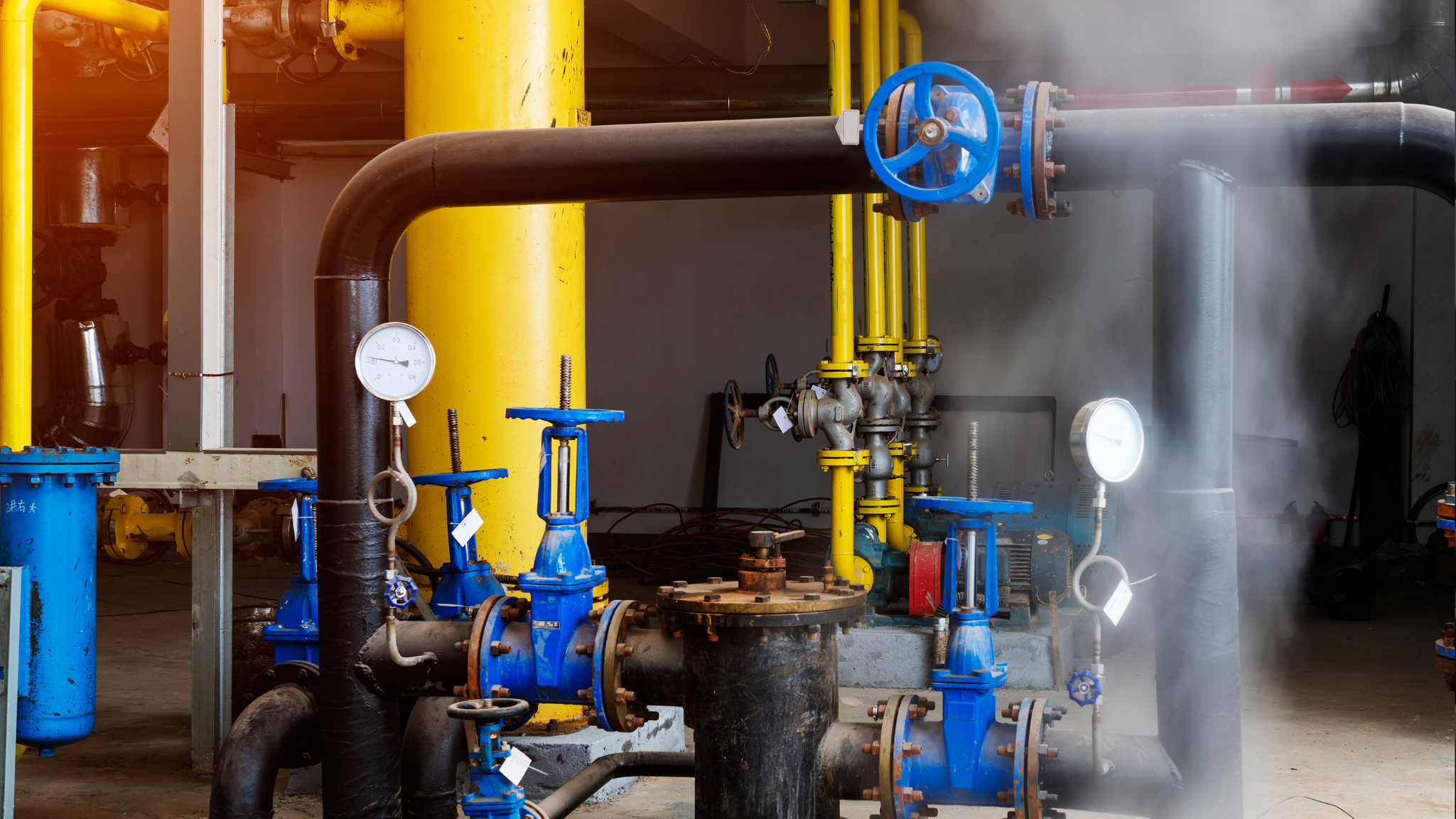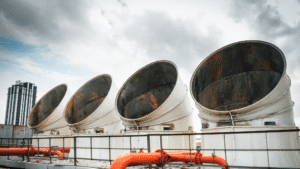Boilers may run on steam, but it’s corrosion that puts real pressure on facility managers. Without the right boiler rust inhibitor, internal corrosion can quietly reduce heat transfer, increase fuel costs, and eventually lead to catastrophic failure. In many cases, the problem starts small—often with excess oxygen in the boiler water or inconsistent treatment.
Preventing rust isn’t just about adding chemicals. It’s about using a corrosion inhibitor that matches the conditions of the system. A dependable boiler treatment program must align with the unit’s pressure range, metallurgy, and feedwater quality to be effective.
At ETI, we’ve spent decades formulating boiler treatment solutions that protect industrial steam boilers while reducing risk and delivering lower cost operation over time. In this article, we’ll explore what makes a boiler rust inhibitor work, and how to choose one that offers lasting protection for your system.
Why Rust is a Problem in Boiler Systems
Corrosion in boiler systems is destructive. Rust forms when iron or steel reacts with oxygen and moisture in the boiler water, producing iron oxide deposits that gradually weaken the system. This process is accelerated by high temperatures, low pH, or when operators regularly add fresh water without proper pre-treatment.
Common forms of corrosion include general metal thinning, localized pitting (small holes that can lead to leaks), and under-deposit attack where scale, lime, or sludge traps oxygen against metal surfaces. These issues can go unnoticed until performance drops or a costly failure occurs.
Beyond structural damage, rust buildup and deposition decrease thermal efficiency, increase fuel use, and raise maintenance demands. In severe cases, corrosion can cause iron fouling, blockages in tubes, or leaks in pressure components – especially in systems using mixed metals like aluminum, brass, or copper.
Effective boiler treatment depends on selecting a formulation that can not only treat the root causes of corrosion, but also adapt to the specific demands of your water chemistry and operating conditions.
Core Components of an Effective Rust Inhibitor Blend
Formulating a reliable boiler rust inhibitor starts with understanding how each chemical component contributes to corrosion control. Nitrite-based corrosion inhibitors are common in closed-loop heating systems with aluminum or cast iron components. While off-the-shelf products exist, tailored blends give you the flexibility to match central heating system needs and water conditions with precision.
Here are the core components ETI considers when blending high-performance corrosion inhibitor chemicals:
Oxygen Scavengers
Dissolved oxygen is one of the leading culprits behind internal corrosion. Scavengers like sodium sulfite, DEHA, and erythorbate react with oxygen before it can reach metal surfaces. To effectively treat high-pressure systems, volatile scavengers may be preferred to prevent residue buildup.
Alkalinity Builders and pH Buffers
Corrosion accelerates in acidic environments. Raising the pH to a slightly alkaline range helps neutralize corrosive ions and create a more stable environment. Sodium carbonate, sodium hydroxide, and phosphate blends are common tools in this category.
Film-Forming Amines
These specialized corrosion inhibitors create a microscopic barrier between the water and metal surfaces, offering vital protection in areas like condensate lines and heat exchangers. These corrosion inhibitors are especially effective in water systems containing cast iron or aluminum, where direct exposure to oxygen and acidic conditions can lead to accelerated pitting and corrosion.
Dispersants and Chelating Agents
These additives keep suspended iron and scale-forming minerals from settling and creating under-deposit corrosion. They also support system cleanliness, which enhances the effectiveness of other inhibitors in the blend.
Natural and Synthetic Organic Inhibitors
Tannins and polymers are often used to stabilize metal surfaces and reduce oxidation. Tannins, in particular, are gaining popularity as a more sustainable alternative to traditional corrosion inhibitor chemicals in both boiler and central heating systems.
Customization Based on Boiler Type and Water Quality
No two boiler systems are built the same. That’s why a one-size-fits-all rust inhibitor often falls short. Real boiler treatment success depends on matching the chemistry to your system’s pressure, metals, and boiler fill water quality.
Steam boilers in industrial settings demand corrosion inhibitors that hold up under high temperatures and pressure. Volatile oxygen scavengers and film-forming amines are often preferred for their thermal stability and ability to protect steam lines and return systems.
Closed-loop and hot water systems run cooler but are still vulnerable to long-term corrosion. These setups benefit from low-toxicity, stable blends like tannin-based inhibitors, especially when aluminum or cast iron is involved.
Water source matters too. Municipal water may need buffering for hardness and chlorine. RO or well water often lacks alkalinity and may require adjustments. High iron levels make dispersants and chelating agents more critical to prevent localized damage.
If you’re unsure where to start, the table below breaks down common system types, water sources, and what to look for in a boiler rust inhibitor. It’s a quick way to align treatment strategy with real-world conditions.
Boiler Treatment Needs by System Type and Water Source
| System Type | Typical Challenges | Recommended Rust Inhibitor Features | Water Source Considerations |
|---|---|---|---|
| Steam Boiler (High Pressure) | High temps, oxygen ingress, scaling | Volatile oxygen scavengers, film-forming amines | May require dispersants to manage scale and iron content |
| Closed Loop System | Slow oxygen ingress, pitting, mixed metals | Nitrite-based or tannin blends, pH buffers | Monitor nitrite levels, check for fresh water additions |
| Hot Water System | Variable pH, lime buildup, localized corrosion | Alkalinity boosters, chelating agents, film-forming additives | Check alkalinity and hardness of boiler fill water |
| Wood Boiler (Hydronic) | External contamination, irregular makeup water | All-organic inhibitors, tannins, dispersants | Use stable blends that tolerate brass, aluminum, and copper |
| Boilers Using Well Water | Low buffering, potential for scale and fouling | Alkalinity adjusters, customized formulation | Pre-treatment to remove hardness and balance pH |
| Boilers Using RO Water | Very low mineral content, risk of low pH | pH buffers, low-toxicity inhibitors | Monitor for corrosiveness and treat to stabilize chemistry |
Field Application and Monitoring Best Practices
A rust corrosion inhibitor’s effectiveness doesn’t stop at the formulation. How it’s applied and monitored in the field determines whether corrosion is truly under control.
For most systems, injection occurs at the feedwater tank, deaerator, or directly into the boiler feed line. The choice depends on system design, chemical volatility, and where protection is most needed. Uniform distribution is critical, especially in large or complex systems.
Monitoring is equally important. Key parameters include pH, conductivity, total and free alkalinity, iron content, and nitrite levels, particularly in systems where nitrite-based inhibitors are used to protect ferrous metals and maintain passivation layers. For oxygen scavengers, oxidation-reduction potential (ORP) is a useful indicator of performance. These values should be tracked regularly (remotely or with test strips) to ensure consistent treatment and catch any early signs of corrosion or imbalance.
In higher-risk applications, like high-pressure systems or facilities with stringent compliance requirements, automated monitoring systems or periodic lab analysis may be necessary. This is to validate treatment effectiveness and adjust dosing accurately.
An effective boiler treatment pairs the right chemistry with accurate dosing and data-informed adjustments. When monitored and applied correctly, corrosion inhibitors help maintain optimal steam production, minimize scale-related inefficiencies, and extend the life of key boiler components.
Build a Compatible Boiler Treatment Strategy
Corrosion doesn’t wait, and neither should your boiler protection plan. Whether you’re managing a steam boiler, closed loop, or high-efficiency hot water system, let ETI help you build a custom boiler rust inhibitor plan designed for your system pressure, water chemistry, and equipment lifespan goals.
For more details on treatment options tailored to different boiler system applications, including steam, hot water, and closed-loop heating systems—see ETI’s boiler rust treatment solutions.





